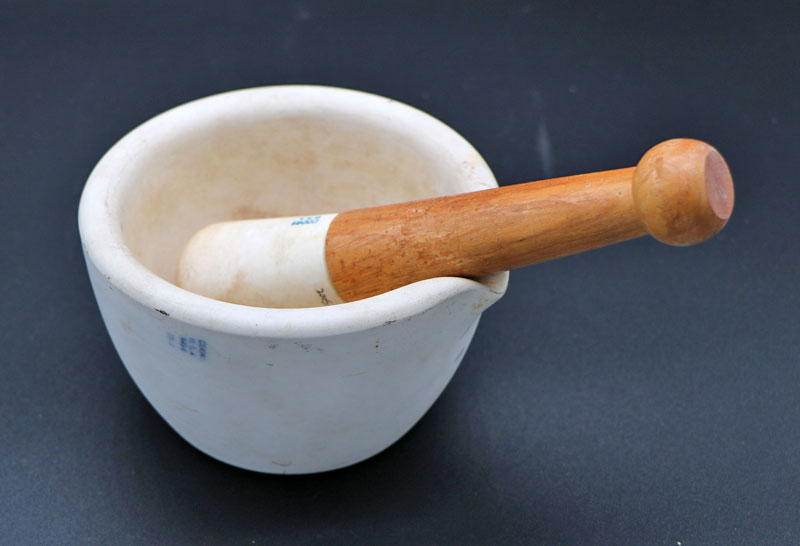The following 21 listings were found:

Apothecary Bottle (Oil Bottle)
This apothecary bottle, known as an oil bottle, was used for storage of Ol. Amygd. D. – Oil of Sweet Almonds. The glass stopper does not secure the bottle. It is designed as a tube with a slight spout at the top, to allow easy pouring, and a groove at the base, to allow drops of oil to flow back into the bottle. A dome-shaped cap, which would fit over the stopper and protect the bottle’s contents, is missing. This bottle was manufactured in the mid to late 1800s by glassmaker Whitall Tatum & Co. (USA). Its decorative gold label was applied to a recessed panel and covered with curved glass that was cemented in place. The bottle is 10 inches in height. Historically, Oil of Sweet Almonds was used as a healing agent in a poultice applied to a wound or to the perineum after traumatic childbirth.
Duff Pharmacy Museum: #3153.

Apothecary Bottle (Syrup Bottle)
This apothecary bottle was used as shelfware for storage of Syr. Eastons – Easton’s Syrup. It was designed with a glass mushroom stopper that is secure but fits loosely in the neck to help prevent it from becoming stuck with syrup. The bottle’s label was applied to a recessed panel and covered with curved glass that was cemented in place. The bottle is 7.5 inches in height. Easton’s Syrup contained iron phosphate, quinine and strychnine and was used as a tonic.
Duff Pharmacy Museum: #675.

Apothecary Bottle (Tincture Bottle)
Apothecary bottle used for storage of Ess. Rubi Idaei. – Essence of Raspberry Leaf. It was manufactured by Whitall Tatum & Co. (USA) in the mid to late 1800s. The gold label was applied to a recessed panel and covered with curved glass that was cemented in place. Its narrow neck signifies it is a “tincture” bottle, used for liquids. The bottle is 7.5 inches in height. The glass stopper, known as a mushroom stopper due to its shape, has been ground to provide a close fit.
Duff Pharmacy Museum: #3154.

Apothecary Bottles (Saltmouth)
These wide-necked apothecary bottles, known as saltmouths, were used to store medications in solid form (e.g., crystalline or powder). They were manufactured by C.L.G Co (Carr-Lowrey Glass Co., Baltimore, Maryland) which opened in 1889. They feature labels that were applied to recessed panels and covered with curved glass and had close-fitting ground-glass mushroom stoppers. Bottle height: 4.5 inches.
Camph. Monobrom. (Camphora Monobromata or Monobromated Camphor) was used as a sedative hypnotic; Trional or Methylsulphonal was thought to have hypnotic effects; Iodol or Tetraiodolpyrrole had antiseptic properties.
Duff Pharmacy Museum: #657 (Camph. Monobrom.) #650 (Trional) and #651 (Iodol)
.

Apothecary Jar (Milk Glass)
Milk glass apothecary jar and lid made by Whitall Tatum & Company, USA, mid- to late-1800s. The Latin inscription, Macis, is on a curved, gold-coloured raised glass label. This indicates that it was intended for storage of mace, a spice prepared from the covering of the nutmeg seed. Height: 6 inches. Donated by Gerald Buckley, Halifax, NS.
Duff Pharmacy Museum: #3150.
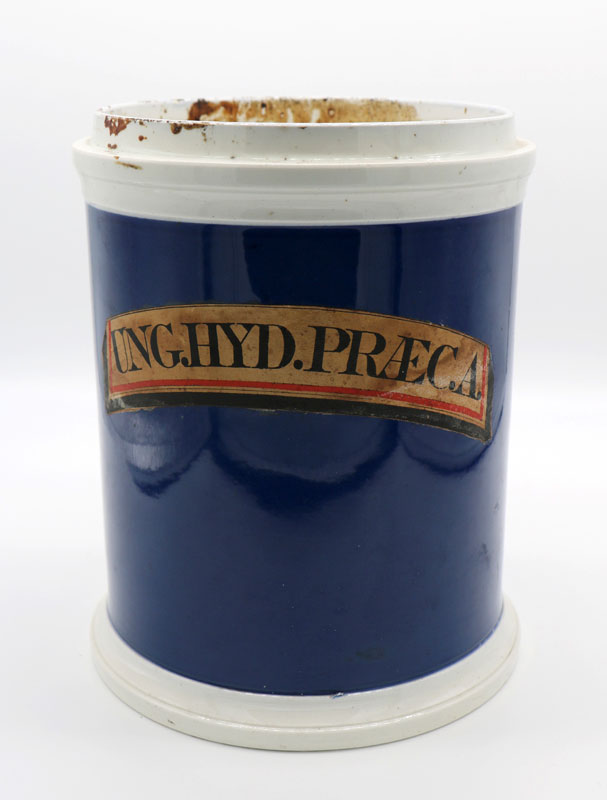
Apothecary Jar (Queensware)
Apothecary jar used to store mercury ointment. Made from lead-glazed earthenware, known as queensware, developed by potter Josiah Wedgwood (1730-1795).
Latin inscription: Ung. Hyd. Praeca Translation: ointment (Ung. - Unguentum) mercury (Hyd. - Hydrargyri). Diameter: 5.5 inches; Height: 8 inches. Lid is missing. Donated by Jack McKenna, Pictou, N.S.
This jar once belonged to J.D.B. Fraser, who opened a drugstore in Pictou, Nova Scotia, in 1828. He was one of the first and likely the very first pharmacist to operate a drugstore on his own, without a physician, in Nova Scotia. Typically, the source of drugs in Nova Scotia prior to this date was from physicians, who both tended to the sick and supplied medications.
Duff Pharmacy Museum: #717.
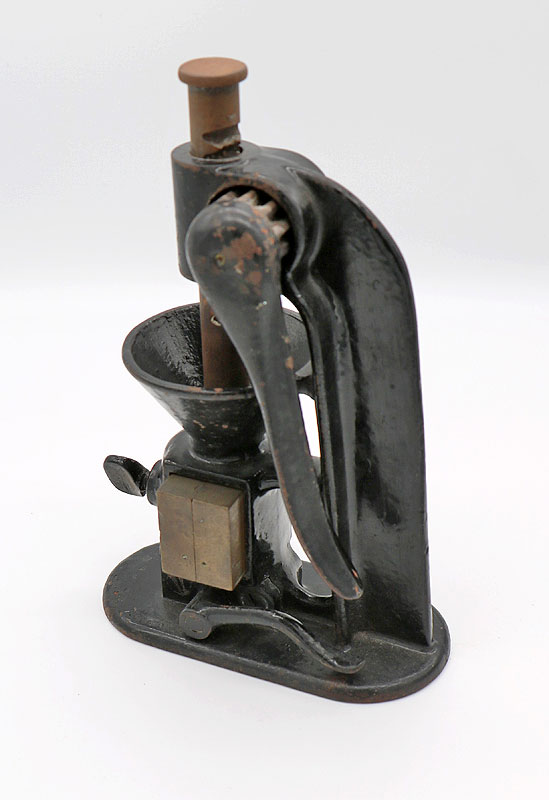
Archibald Suppository Press
Originally designed by Henry C. Archibald in 1879 for making compressed suppositories. The central funnel-shaped area is the “hopper” where a mixture of medicinal ingredients and suppository base (e.g., cocoa butter) is placed. The plunger is lowered from the top, into the hopper, through use of the hand-lever. This forced/pressed the suppository mixture into the suppository mold (brass-coloured in photo). Mold is held in position with black screw. Suppository press is 7 inches in height.
Duff Pharmacy Museum: #1083.
See Related: Divided Suppository Mold; Individual Suppository Mold; Urethral Suppository Mold.
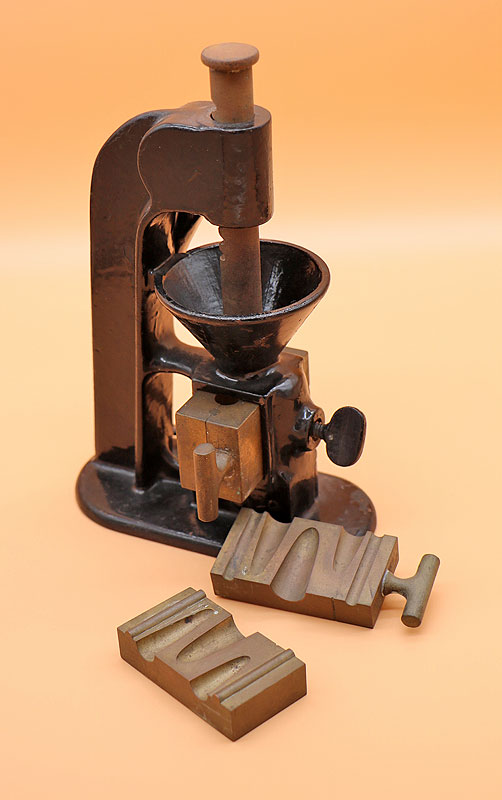
Divided Suppository Mold used with Archibald Suppository Press
Two-part brass suppository mold (opened longitudinally). Mold can make three different sized rectal suppositories. Tongue-in-groove is used to connect the two parts. Used with the Archibald Suppository Press, also shown in photograph. The ability to open the mold greatly improved the ease of removal of the suppositories. The handle assists placement and removal of the mold from the press. Duff Pharmacy Museum: #1084
See Related: Archibald Suppository Press; Individual Suppository Mold; Urethral Suppository Mold.
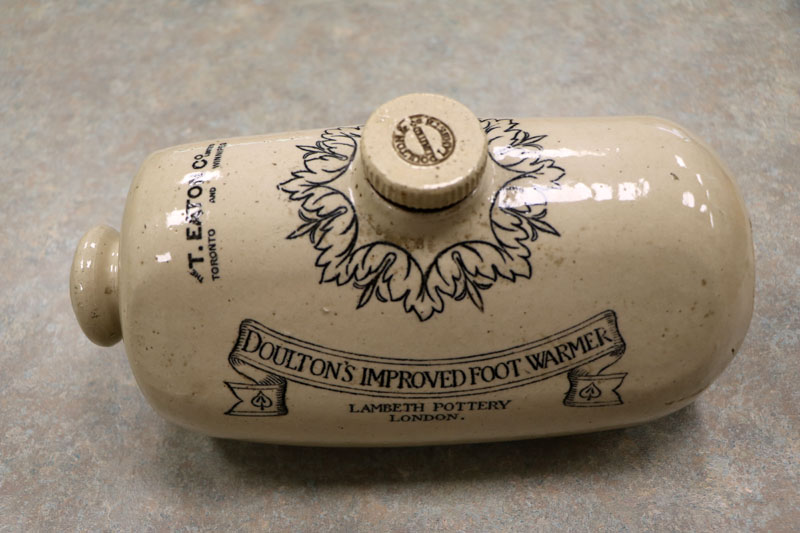
Doulton's Improved Foot Warmer
Stoneware ceramic foot warmer manufactured by Doulton Lambeth Pottery, London, UK, a division of Royal Doulton. It was sold in Canada by the T. Eaton Company, Toronto, through its catalogue. Ceramic foot warmers, in several sizes and with various decorative fringes, were first made by British pottery manufacturers in the early 1900s. The one pictured here is circular with two flattish sides. It is 11.5 inches in length, with a knob at one end and an opening on top. Hot water was poured into the opening, and it was closed tightly with the screw cap. The foot warmer functioned similarly to a hot water bottle and was used to warm beds, unheated carriages, sleighs, or train compartments.
Duff Pharmacy Museum: #3195.
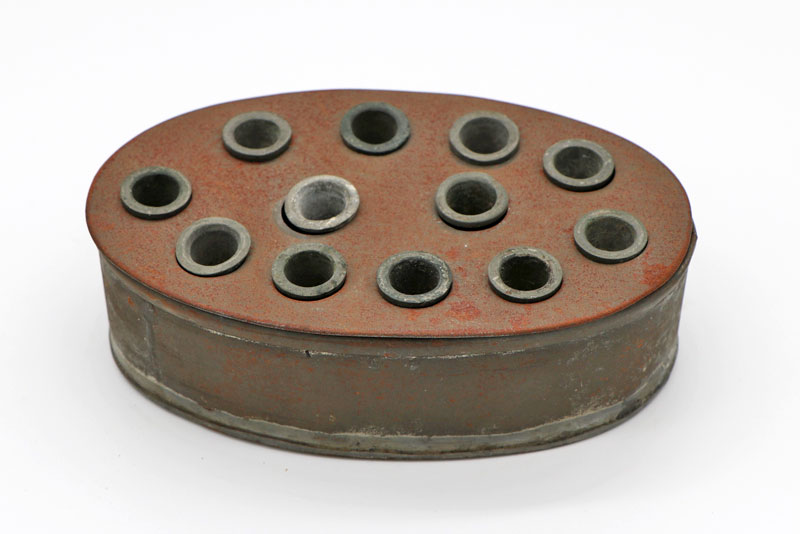
Individual Suppository Mold
Individual suppository molds made from pewter in an oval, two-part metal dish. Used for making rectal suppositories. The top contains 12 perforated holes in which individual molds were placed. The bottom was filled with chopped ice or snow and the two parts attached. Warm melted medicinal ingredients were poured into the molds. Once they had thoroughly cooled, the suppositories were removed by inverting each mold and tapping it lightly. This type of mold was first manufactured in 1860, and by 1875 there were 20 different molds on the market. Prior to using molds to make suppositories they were prepared by hand, using a rolling technique.
Duff Pharmacy Museum: #542.
See Related: Divided Suppository Mold; Archibald suppository Press; Urethral Suppository Mold.
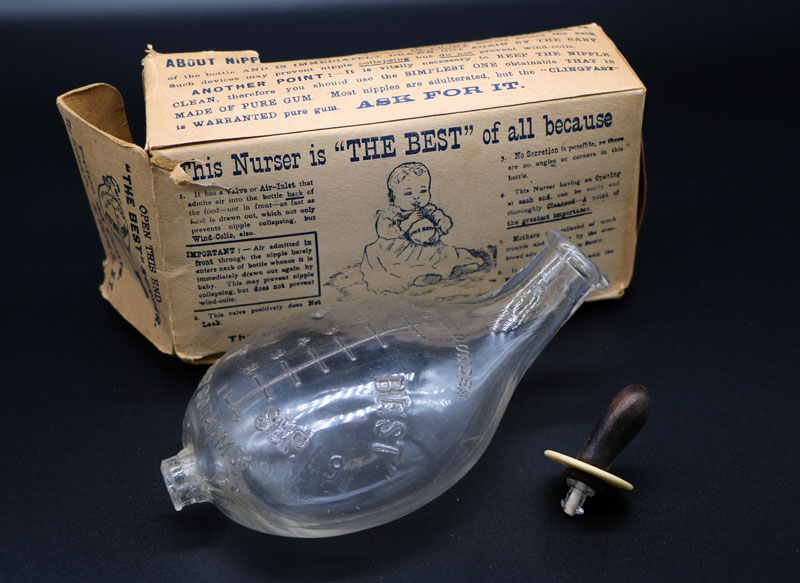
Infant Feeder - The Best Nurser
There is evidence that babies have been fed using bottles, cups, jugs, or other devices for thousands of years. Glass feeding bottles came into use in the nineteenth century and by the 1850s were affordable for most families. Glass bottles evolved throughout the century with various shapes and devices used to regulate the flow of milk and to allow effective cleaning to prevent disease.
The infant feeder, "The Best Nurser", was patented on September 1,1891 by The Gotham Company of New York. This nurser is leaf shaped with a thin neck where a removable rubber nipple is attached. At the other end, it has a removable rubber air-inlet stopper. Having an opening at each end made it easily cleaned. The air-inlet valve minimized the air ingested by the baby and provided a steady flow of food without exertion. The words "THE BEST" are inscribed on the glass. It was advertised as the only practical, convenient, and safe bottle because it allowed freer suction, was leakproof, had a non-collapsing nipple, and was easily cleaned. An early advertisement directed to the drug store market suggested that "Druggists who aim to be progressive and keep the best that’s going would do well to order a sample dozen."
Duff Pharmacy Museum: #809
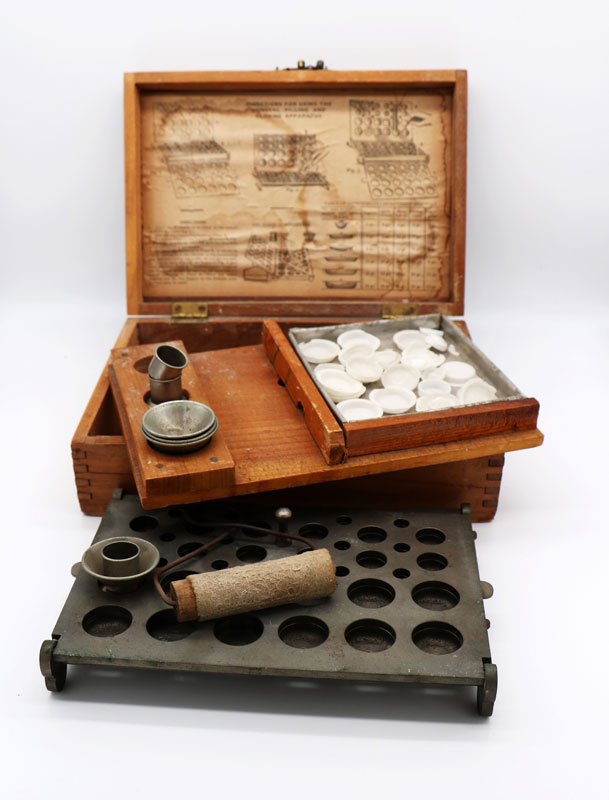
Konseal Apparatus or Cachet Apparatus
Used for filling and sealing cachets. Cachets or Konseals pre-date capsules. They provided a sealed, edible enclosure for bad-tasting solid medication that was to be taken orally. Cachets were prepared from two concave pieces of wafer made from rice flour and water. After one wafer (concave side down) was filled with medication, the other wafer was placed on it, concave side up. The two wafers were sealed by moistening the margins and applying firm pressure.
The hinged wooden box (9.25" x 3.25" x 6.75") was used to store the equipment for making cachets. The top of the box is labelled Konseal Apparatus with instructions for preparing Konseals attached to the inside of the lid. The main apparatus is a hinged, three-part metal plate with various sized holes. Wafers are placed in appropriately sized holes, concave side down. Medication is placed inside, using metal cones (funnels) and tampers to aid with filling. The margin of the wafer is moistened, a second wafer of equal size placed on it and the two are sealed with pressure. Manufacturer: J. M. Grosvenor & Co. Boston, Mass., USA. Date: c. 1880.
Cachets were rigid at the time of preparation. Patients were instructed to moisten the cachet prior to administration. This caused the cachet to become soft and slippery and more easily swallowed.
Duff Pharmacy Museum: #1051.
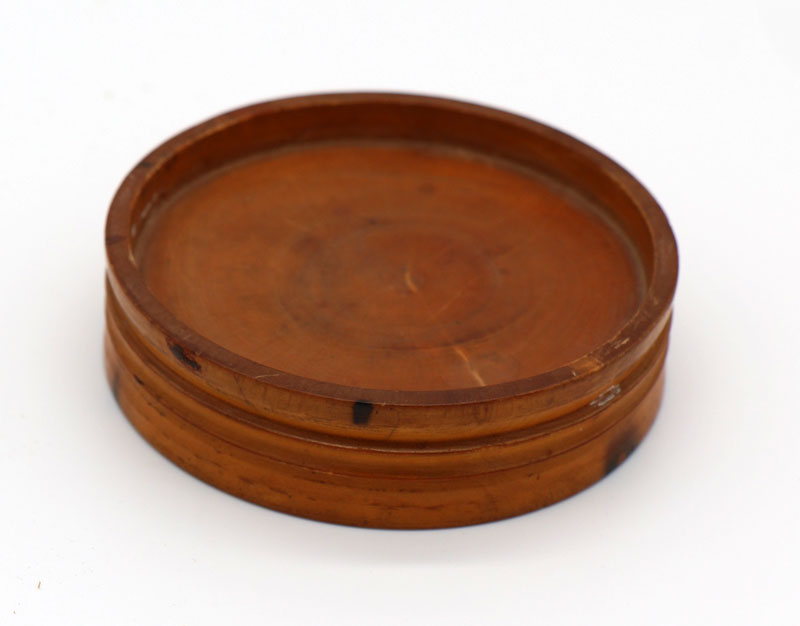
Pill Finisher or Pill Rounder
Used to make round (globular-shaped) pills. Description: A smooth wooden disc (diameter 2.75 inches), with raised rim.
Pills prepared by hand or with the assistance of a Pill Roller were “rounded” by rolling them on the Pill Finisher. A spatula or the flat bottom of a Pill Polisher would be used to rotate/move the pills around, thus forming smooth, round pills. The Pill Finisher also could be held in the hand, with the rimmed side down, and used to rotate pills on a solid surface below, to cause the pills to become rounded. Dates: Early 1800s to early 1900s. Duff Pharmacy Museum: #583.
See related: Pill Roller; Pill Polisher; Pill Tile.
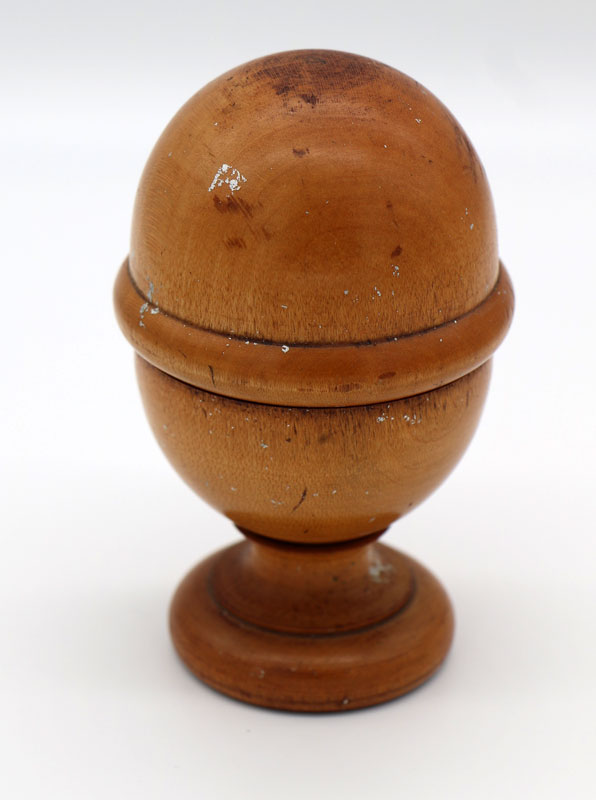
Pill Polisher or Pill Silverer
Used to coat pills with gold or silver leaf. Description: Egg-shaped wooden device with two parts; detachable at the central region; hollow, with smooth interior; height 4.25 inches.
Gold or silver leaf intended for coating the pills was placed in the lower section of the Pill Polisher. Pills prepared by hand or with the assistance of a Pill Roller were moistened with a sticky substance (e.g., syrup) and also placed in the lower part of the Pill Polisher. The top was reattached, and the pills were rotated within to allow coating. These gold or silver coated pills were popular with rich patrons of a pharmacy in the 1600s. Talc was also used as a pill coating to prevent pills from sticking to each other. Sugar-coatings on pills came into use by the mid-1800s. Duff Pharmacy Museum: #574.
See related: Pill Roller; Pill Rounder; Pill Tile.
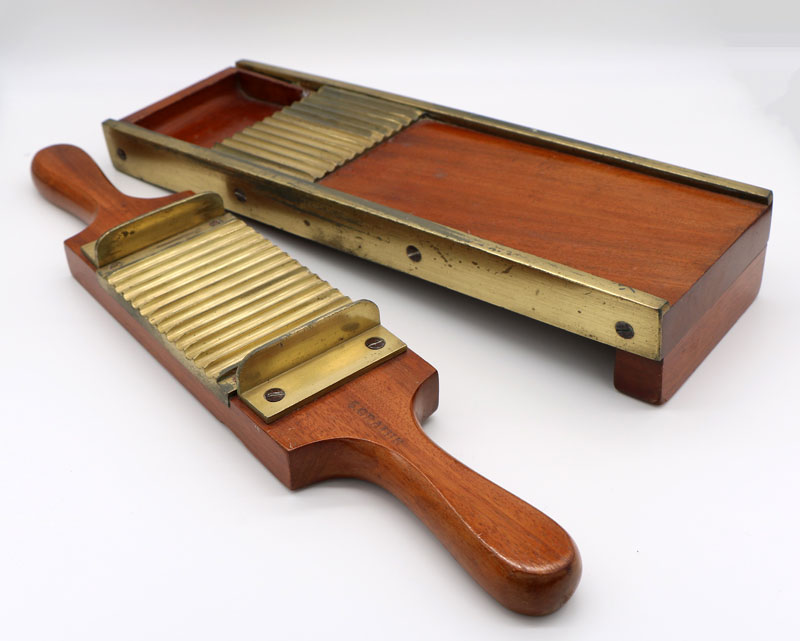
Pill Roller or Pill Machine
Used in pill making. Left – two handled paddle (roller). Right – inclined base with capacity to make 12 pills. Both parts are made from wood, with brass hardware and brass plates with semi-circular grooves. Its use made pill making faster as 12 could be formed at the same time.
Medicinal ingredients and a binding agent are prepared into a pill mass using a mortar and pestle. The pill mass is then rolled by hand into a uniform log (cylinder) using the smooth wooden back of the paddle on the smooth end of the base. The uniform log is then placed on the grooved brass plate of the base and the grooved side of the paddle is matched to the grooves on the base. The paddle is moved back and forth with enough pressure to cut the log into equal parts. Pills are finished by rounding the parts into globular shapes using one’s fingers or a device called a Pill Finisher. Dates: Mid 1800s to early 1900s. Duff Pharmacy Museum: #1068.
See related: Pill Finisher; Pill Polisher; Pill Tile.
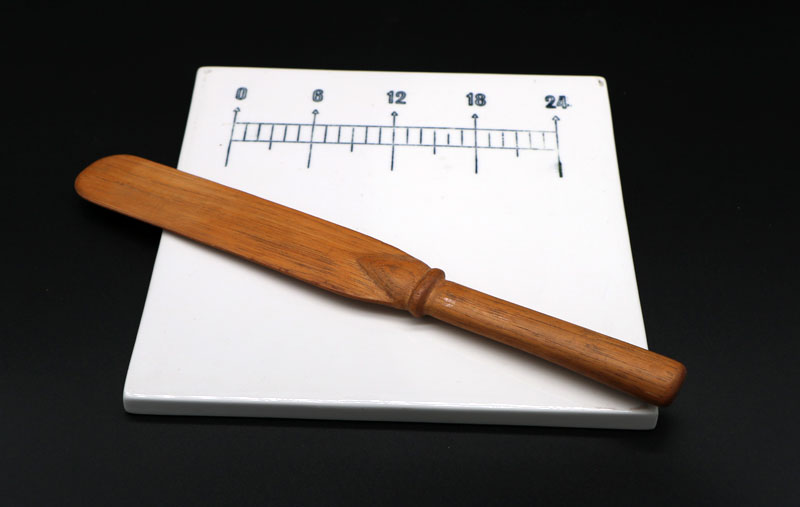
Pill Tile and Spatula
Ceramic tile (7.75 x 7.5 x 0.5 inches) used for preparing pills. First a pill mass of medicinal ingredients and a binding agent is prepared using a mortar and pestle. The pill mass is placed on the pill tile and rolled by hand and with a spatula, into a uniformly shaped roll or cylinder. The roll is placed on the graduated markings on the tile and a spatula is used to divide it into equal parts determined by the markings. The wooden spatula shown is 10.5 inches in length and 1.5 inches at its widest area. Duff Pharmacy Museum: #719 (Pill Tile); #1090 (spatula).
See related: Pill Roller; Pill Finisher; Pill Polisher.
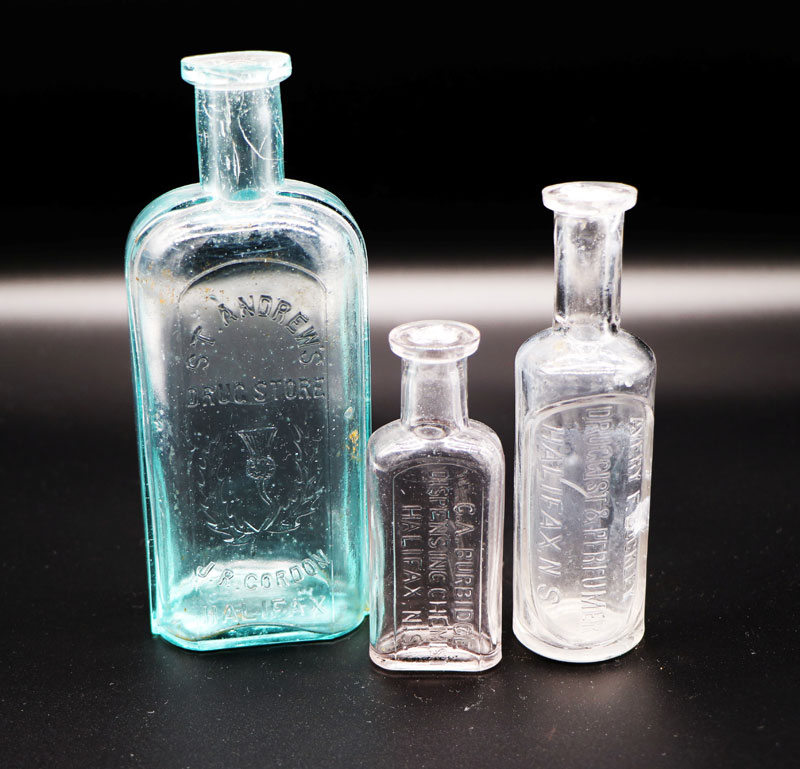
Prescription Bottles (Druggist Bottles/Pharmacy Bottles)
These druggist or prescription bottles were used to dispense liquid medications to the public during the late 1800s. Each bottle is embossed with the name of the pharmacist operating the drugstore and the address where the drugstore was located.
Left: Rounded rectangular bottle with Scottish Thistle, light green glass, 6 inches in height. St. Andrew’s Drug Store, Jacob Street, Halifax, NS. Pharmacist: James R. Gordon, one of the original registrants of the Nova Scotia Pharmaceutical Society, incorporated in 1875.
Duff Pharmacy Museum: #3394.
Centre: Rounded rectangular bottle, clear glass, 3.5 inches in height. Pharmacist: George A. Burbidge, Dispensing Chemist, took ownership of The London Drug Store, Hollis Street, Halifax, NS in 1899. He also was a graduate optician and advertised that he had a complete optical department in the drug store.
Duff Pharmacy Museum: #3546.
Right: Round bottle with long neck, clear glass, 4.75 inches in height. Pharmacist: Avery Fillis Buckley, Druggist and Perfumer, Halifax NS. Began operation of The Medical Hall Drug Store, Brunswick Street, Halifax, NS in 1879. He opened several more drugstores before becoming a physician in 1902.
Duff Pharmacy Museum: #3381.
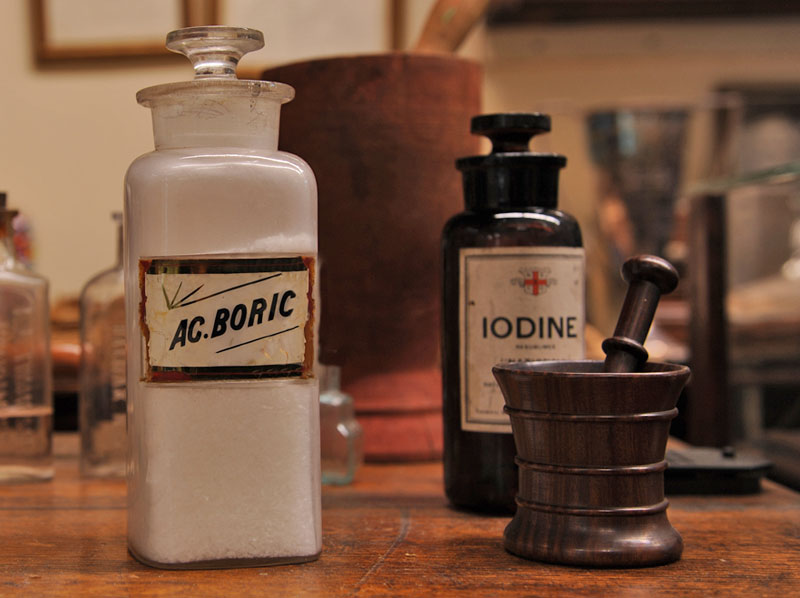
Shelf Ware Bottle containing Boric Acid; Mortar and Pestle; Amber Glass-stoppered Bottle of Iodine
Shelf Ware Bottle – Used by pharmacists as early as the late 18th century as a bulk container for storage of medicinals. Bottle on left made from clear glass with a glass stopper. The drug name is written in Latin: AC Boric (boric acid or boracic acid). Boric acid was used as an antiseptic in different forms (powder, ointment or lotion) in 1917 to help the injured following the Halifax Explosion.
Mortar and Pestle – A symbol of pharmacy. Used for grinding, pulverizing and mixing drugs. The mortar is the bowl-shaped component in which the substance (e.g., drug crystals or herb) is placed. The pestle is used to break down the substance into smaller particle sizes. A mortar and pestle can also be used to combine a drug powder with a vehicle (e.g., petroleum jelly) to prepare an ointment. Mortars and pestles have been used since ancient times and can be made from a variety of materials, including stone, wood, glass, marble, brass and iron.
Bottle on the right is made from amber coloured glass with a glass stopper. It contains Iodine (sublimed) sold by the National Drug and Chemical Company, a Canada-wide drug wholesaler that opened a Halifax Branch of the Company in 1906. Iodine was first recognized to have antiseptic properties in the early 1800s.

Tablet Triturate Mold
Used for making small cylindric molded tablets known as tablet triturates. The black rubber mold consists of a base plate with alignment pegs and a top plate with corresponding holes. The tablets were made by filling the holes in the top plate evenly with a moistened mixture of drug and diluent. After the mixture hardened, the top plate was aligned over the base plate and pressed down to release the tablets. Capacity 50 tablets. Dates: Mid 1880s until well into the 20th century.
Duff Pharmacy Museum # 1070.
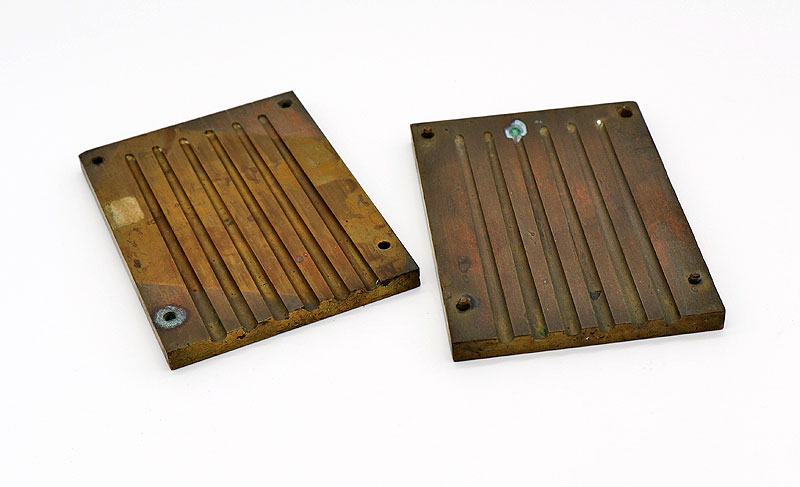
Urethral Suppository Mold or Bougie Mold
Two-piece brass mold held together with screws. Used to prepare cylindrical suppositories for insertion into the urethra. Mold can form 6 urethral suppositories, also called bougies. Dimensions of mold: 4.5” x 3.25” x 0.5”. Molded suppositories were cut into appropriate lengths, as necessary, for female and male urethras. In the later part of the 1800s, urethral suppositories were prepared using a base of 3-parts white gelatin, 1-part glycerin and 1-part distilled water.
Duff Pharmacy Museum: #1448.
See Related: Archibald Suppository Press; Individual Suppository Mold; Divided Suppository Mold.
